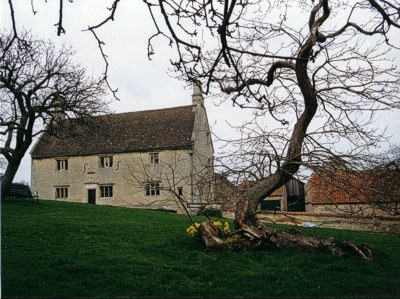
Apples love bones
 The
most vivid part of the entire book is a quote from a nineteenth century
text about apples and bones. Roger Williams, the founder of Rhode
Island, was buried with his wife beside a large apple tree. The
tree was attracted to his bones and sent a root from his skull, down
his backbone to the hips, then divided in two to trace each leg.
The root bent at the knees and formed a man-like shape, in the process
digesting every bit of Roger Williams' body.
The
most vivid part of the entire book is a quote from a nineteenth century
text about apples and bones. Roger Williams, the founder of Rhode
Island, was buried with his wife beside a large apple tree. The
tree was attracted to his bones and sent a root from his skull, down
his backbone to the hips, then divided in two to trace each leg.
The root bent at the knees and formed a man-like shape, in the process
digesting every bit of Roger Williams' body.
From this anecdote,
Michael Phillips determined that apple trees like bones. In fact,
calcium is a limiting factor in the trees' fruit production, just as
it
is for tomatoes. If the proportions of calcium, magnesium,
and
potassium aren't just right in the soil, the apple tree may not be able
to suck up enough calcium and the fruits will develop bitter pit.
Poultry bones are, in
fact, one of the few waste products that shouldn't be a waste product
on our farm. I turn carcasses into rich stocks, but the stewed
bones are no longer safe for Lucy to consume, so we carefully bury them
out of her reach. Given apple trees' need for calcium, we've
started putting those carcass pits around our young apple trees in hope
that the trees roots will find the bones and suck up the precious
calcium. Maybe someday we'll dig up the apple roots and find them
curled into the shape of a bird.
| This post is part of our Growing Organic Apples lunchtime series.
Read all of the entries: |
Want more in-depth information? Browse through our books.
Or explore more posts by date or by subject.
About us: Anna Hess and Mark Hamilton spent over a decade living self-sufficiently in the mountains of Virginia before moving north to start over from scratch in the foothills of Ohio. They've experimented with permaculture, no-till gardening, trailersteading, home-based microbusinesses and much more, writing about their adventures in both blogs and books.
Want to be notified when new comments are posted on this page? Click on the RSS button after you add a comment to subscribe to the comment feed, or simply check the box beside "email replies to me" while writing your comment.
- Remove comment

- Remove comment
